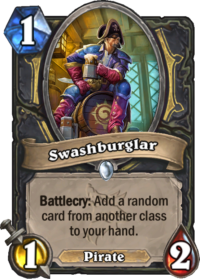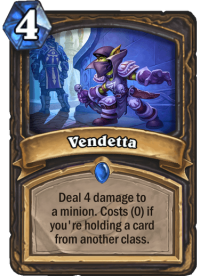It took many years and multiple iterations, but Thief Rogue has finally emerged from meme status to the top dog of the metagame. What kind of cards did it take to get us there, what were its previous failures and what does this all tell us about Hearthstone’s card design? Let’s enter the vault and steal some valuable insights!
Burgle: A Poor Way to Get Started
Skim through Rogue’s Classic set or even the earliest of expansions and you will find no mention of any card that would be a fit in today’s Thief archetype. Snatching cards from another class simply wasn’t a part of Rogue’s identity around the time the game was released. This is in part due to the fact that resource generation was a significantly smaller part of the gameplay experience as it is today. Nevertheless, it’s interesting to note just how slowly Team 5 introduced this particular mechanic as a facet of the class’ identity over time.
In fact, the first such card was released in The Grand Tournament back in August 2015, Burgle, which was how these sort of archetypes were known as for a very long time on the forums. Eventually, many players have moved from calling it Burgle Rogue to Thief Rogue, one of those interesting little linguistic dances in the competitive card game communities, which may have had something to do with the fact that the original card in question was absolute hot garbage.
The reason behind why Burgle is such a bad card is a great starting point in the discussion over how this archetype finally reached the spotlight. Random cards are generally not synergistic, which makes relying on them a fairly poor strategy in a high power-level format. (Contrast and compare with Arena where card generation is near-identical, and sometimes even superior, to drawing cards from your deck.)
This means that you’d need a massive amount of random resources in a single card to make this a worthwhile value tool in a slower matchup. Think Cabalist's Tome, though even that had the advantage of pulling from an extremely impactful pool of class cards.
Well, Burgle is basically just a very poor (and unethical) man’s Arcane Intellect. This makes it extremely slow. The card wouldn’t even see play in today’s Thief Rogue decks. Couple this with the fact that Rogues were never really that good at playing the control game, to begin with, and it’s clear how this ultimate Timmy archetype was dead on arrival back in 2015.
The Growth of Rogue’s Thievery

Small sprinkles of support were printed over time after the introduction of the Standard format. Undercity Huckster arrived with Whispers of the Old Gods and the One Night in Karazhan class cards heavily promoted this gameplay approach with Swashburglar and Ethereal Peddler. Shaku, the Collector followed in Mean Streets of Gadgetzan, Hallucination and Obsidian Shard in Journey to Un’goro, Lilian Voss in Knights of the Frozen Throne. A few of them have seen competitive play, and out of all of those, only Swashburglar made it into this year’s Core set.
Blink Fox (still a very decent standalone card at the time with this statline) and Pick Pocket followed from Witchwood, plus the uber-meme that was Academic Espionage (fun, but not even remotely viable) in The Boomsday Project and Stolen Steel in Rastakhan’s Rumble. It was around this time that Pilfer was added to the Classic set, firmly entrenching this aspect of the gameplay in Rogue’s class identity.
It also marked the end of the original wording for good: from this point onwards, these cards generated resources from another class instead of your opponent’s in order to make the mirror matches less mind-numbing for this particular matchup.
Seriously though, imagine what today’s Thief Rogue mirrors would look like if you couldn’t generate any non-Rogue cards. Balanced or not, it would be pretty fun to watch (at least if watching other people’s suffering is your definition of fun).
From 2019 Onwards: A New Identity

Thief Rogue finally got a set of actually good cards in Rise of Shadows, which serve to highlight the real resource this (or any non-synergistic semi-meme) archetype needed for a more competitive power level: tempo. Underbelly Fence and Vendetta became important, if incidental cards in aggressive Rogue decks at the time, with Hench-Clan Burglar also playing a part in forming the meta decks at the time. To contrast and compare, the next set’s relevant cards (Clever Disguise and Bazaar Mugger) were simply too inefficient to see any play.
The year closed out with Dragon's Hoard, a surprisingly impactful card in its own right as part of discovery chains, but again, not something that would allow you to build a deck around generating cards from different classes. Generating random resources has been a large part of what Rogue’s been doing, but it hasn’t had a way to directly leverage getting non-Rogue cards in your hand and deck.
Thief Rogue went into hibernation after that, sleeping through the carnage caused by Demon Hunters in early 2020 and basically the entire pandemic era: no such payoff cards were printed until the release of the latest set, Fractured in Alterac Valley.
Though it required a bunch of nerfs to get there, the archetype has now skyrocketed in power level and popularity, dominating the ladder at the time of writing. It’s so good that tournament organizers had to unban the ultimate meme card, Maestra of the Masquerade, because it plays such a key part in the best deck of the metagame – which is just hilarious.

So what makes it all work? The unparalleled tempo available thanks to the unique interaction between Wildpaw Gnoll and Maestra, which makes every Rogue card “from another class” as long as you don’t reveal yourself, generating constant discounts on what is essentially a 0-2 mana Chillwind Yeti with Rush, not to mention the 6/6 worth of stats for 3 mana on curve in the form of Double Agent. Again, you can see the growth in payoffs: compare Violet Haze with Reconnaissance and Double Agent with Blink Fox. You may have to mostly rely on your initial burst of power in the early game, but as we’ve seen with Gibberling Druid, that’s often more than enough. And it’s not like there isn’t enough late-game juice in there with Edwin, Defias Kingpin and Mr. Smite alongside Shadowcrafter Scabbs.
It’s no surprise that there are many other Rogue archetypes simultaneously emerging in the meta: after all, most of the tools used by Thief Rogue are just universally good. What’s unique here? The nasty tempo swings at a very early juncture enabled by Wildpaw Gnoll and Double Agent. In a sense, everything else is just a bonus.
Now we know what it takes to push a wacky archetype to the top of the win rate charts: 0 mana 4/5s with Rush and 3 mana 3/3+3/3 minions. There’s no other way to go, at least not in Rogue: due to the class’ fragile and finicky nature, no amount of overwhelming late-game resource advantage can get you to competitive viability.

Tess was a beatiful Card, but i Guess yellorambo go.for.the competitive scene and tess nevera ever was… But it could ve Nice if You include in a next card part of this… Maybe add to the new article worh predictions for.the archtype, nerfs in the shorts future, some additions, the Best deck ar day.. so Many things wuuu!
An entire article on Thief Rogue and not a single mention of Tess Greymane?
Bazaar Burglary too! The two main win conditions of the deck in Raven and Dragon metas and you they’re not even mentioned?
Why is Tess not mentioned? She’s literally the most important Burgle card that ever was! Or at least, what cemented the archetype as fun and juicy.